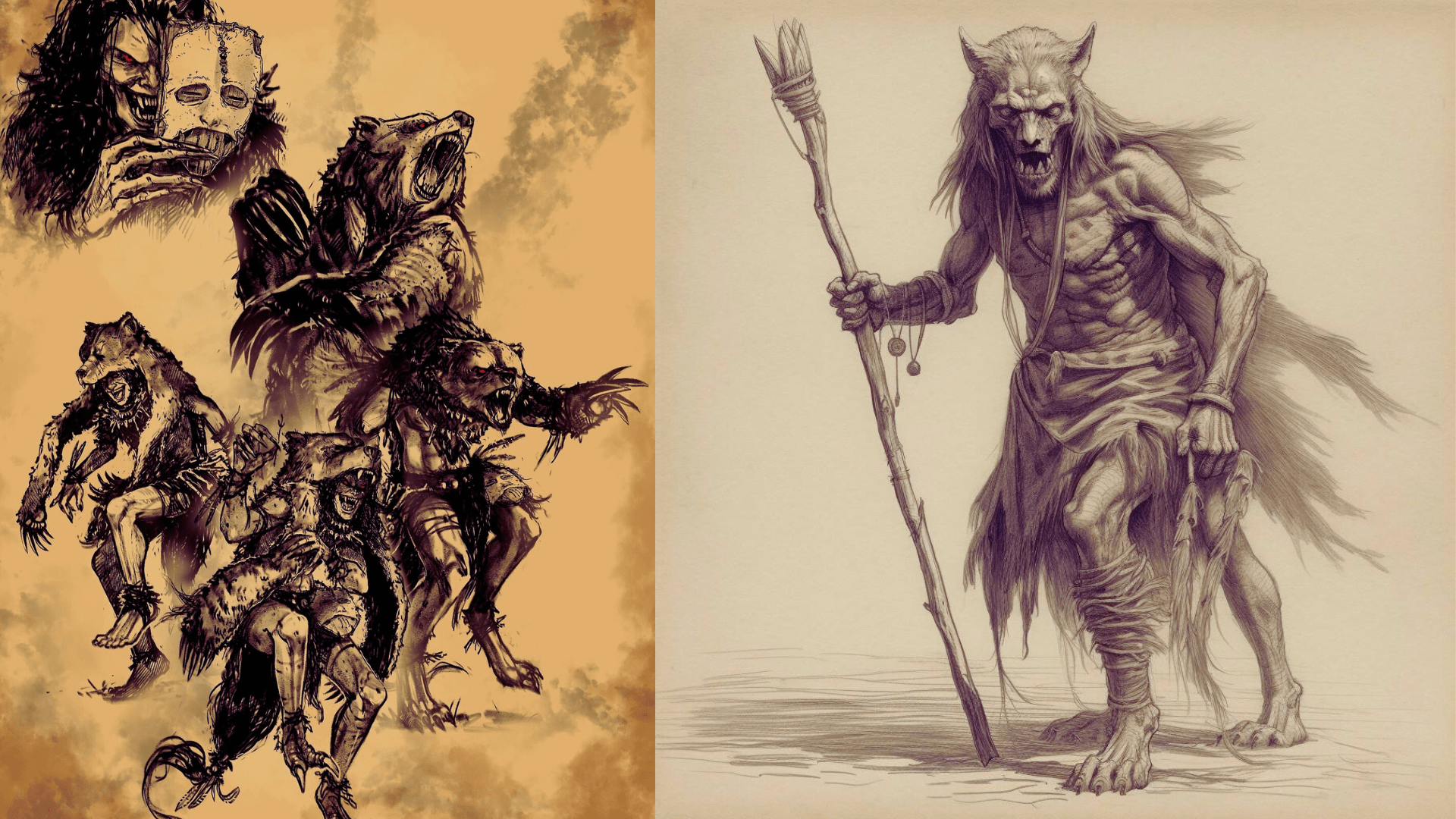Skinwalkers are entities deeply rooted in Native Americans, particularly Navajo, folklore and culture. They are considered to be individuals who have gained the supernatural ability to transform into, control, and impersonate animals. This transformation is not a curse but a desired ability, often associated with dark magic and achieved through committing a significant social taboo, such as the murder of a relative. The term “skinwalker” translates from the Navajo “yee naaldlooshii,” meaning “using it, it goes on all fours.” While primarily a part of Navajo culture, similar versions exist among other tribes like the Hopi, Utes, and more, each with its unique interpretation. Discussion of skinwalkers outside Navajo culture is rare, both due to the reluctance to share these beliefs with outsiders and the sacred and feared status of skinwalkers within the culture itself.
The Origins of Skinwalker Legends
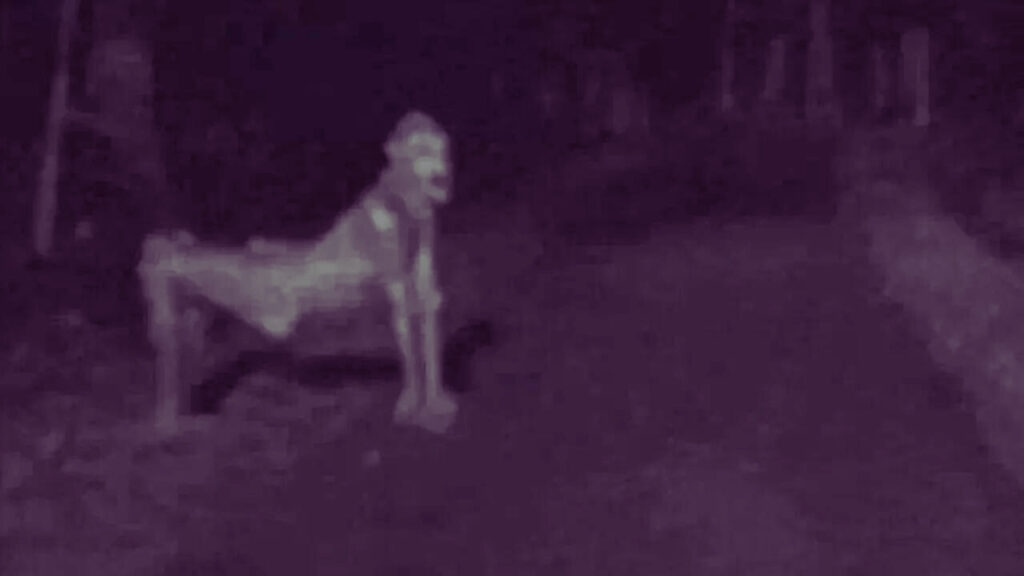
The legend of the skinwalker originates from Native American folklore, with its roots most deeply embedded in Navajo culture. Skinwalkers, known in Navajo as yee naaldlooshii, translate to “by means of it, it goes on all fours.” These beings are considered harmful witches who possess the supernatural ability to transform into, possess, or disguise themselves as animals. This transformation is often associated with malevolent intentions and dark magic. The lore surrounding skinwalkers has gained notoriety beyond its cultural origins, especially with places like Skinwalker Ranch in Utah, which is a hotspot for reported bizarre phenomena and paranormal activity. Skinwalker legends are not just confined to the Navajo; similar beliefs can be found across different Western Indian tribes, each with its unique interpretation and significance within their respective cultures.
Understanding Skinwalkers
The Navajo Perspective
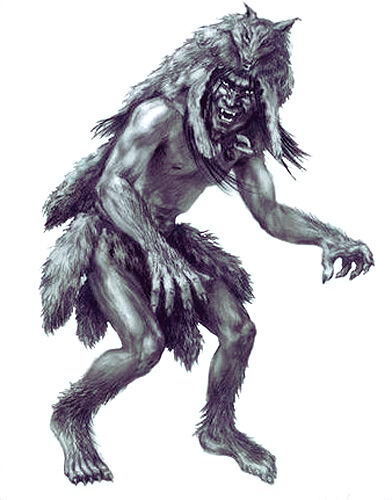
The Navajo perspective on skinwalkers, known in their language as yee naaldlooshii, translates to “using it, it goes on all fours.” This term describes a type of witch capable of transforming into, possessing, or disguising themselves as animals, primarily for harmful purposes. This belief is deeply rooted in Navajo culture and is treated with utmost seriousness and respect. Discussing skinwalkers openly, especially with outsiders, is avoided due to the fear and respect for these beings and their powers. The reluctance to talk about skinwalkers among the Navajo people stems from a desire to avoid attracting their attention or anger. Skinwalkers hold a complex place within Navajo folklore, embodying the darker aspects of witchcraft and the supernatural. Their existence is intertwined with Navajo beliefs about the balance between good and evil, and the potential for individuals to misuse spiritual knowledge for personal gain.
Skinwalkers in Popular Culture
Skinwalkers have infiltrated popular culture, appearing in various movies and TV shows that delve into the unexplained and supernatural. One notable mention is the 2002 TV movie titled “Skinwalkers,” which explores the legend surrounding these entities, often described as spirits of murdered individuals according to a folk legend from Utah. Additionally, TV shows that explore unexplained phenomena, such as “Project Blue Book” on the History Channel and “Evil” on CBS, occasionally incorporate elements related to skinwalkers or similar supernatural beings, highlighting the fascination and mystery surrounding these creatures in the realm of entertainment. Moreover, discussions and mentions of skinwalkers also find their way into online communities, such as Reddit’s horror subreddit, indicating a sustained interest and curiosity about these beings in horror and supernatural discussions.
Characteristics of Skinwalkers
Appearance
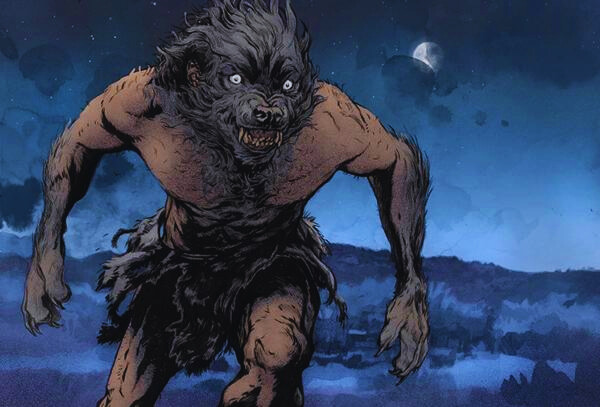
Skinwalkers are deeply rooted in Navajo culture and are believed to possess the ability to transform, possess, or disguise themselves as animals, a characteristic that defines their appearance. They are often associated with wearing the skins of animals they wish to transform into, which is where the name “skinwalker” comes from. This transformation is not just a superficial disguise but includes the physical abilities and traits of the chosen animal, such as strength, speed, and natural instincts. In human form, a skinwalker may appear normal but may display certain unnatural characteristics that can hint at their true nature, such as eyes that reflect light in darkness, mirroring animalistic traits. Additionally, there are beliefs that skinwalkers can steal a person’s face or lock eyes with an individual to absorb or control them, hinting at a deeply supernatural element to their appearance and presence.
Powers and Abilities
Skinwalkers, deeply rooted in Navajo culture, are believed to possess several supernatural powers and abilities. These include:
- Transformation: A central trait is their ability to transform into, possess, or disguise themselves as animals, most commonly those found within their natural environment.
- Imitation: They can mimic the sounds of animals or humans, which they use to lure their victims into traps.
- Physical Enhancements: In their animal forms, skinwalkers may exhibit enhanced strength, speed, or senses beyond those of natural animals.
- Cursing: Some accounts suggest skinwalkers can place curses on people, often through the use of objects belonging to their victims.
Weaknesses
The folklore surrounding skinwalkers is rich and varied, with numerous stories detailing their strengths and weaknesses. However, specific weaknesses of skinwalkers are not explicitly detailed in the search results provided. In general, folklore often attributes unique vulnerabilities to supernatural entities, which can include specific materials (like silver), rituals, or knowledge of the creature’s true name. Given the nature of skinwalkers in Navajo mythology as beings who have turned to dark magic, it’s possible that their weaknesses could be tied to elements that counteract or nullify their magic. Additionally, the concept of skinwalkers feeling pain when experiencing these weaknesses would depend on the specific nature of the weakness and how it affects them. Without direct information from the search results, one can only speculate based on common themes in folklore and mythology.
Encounters with Skinwalkers
Historical Accounts
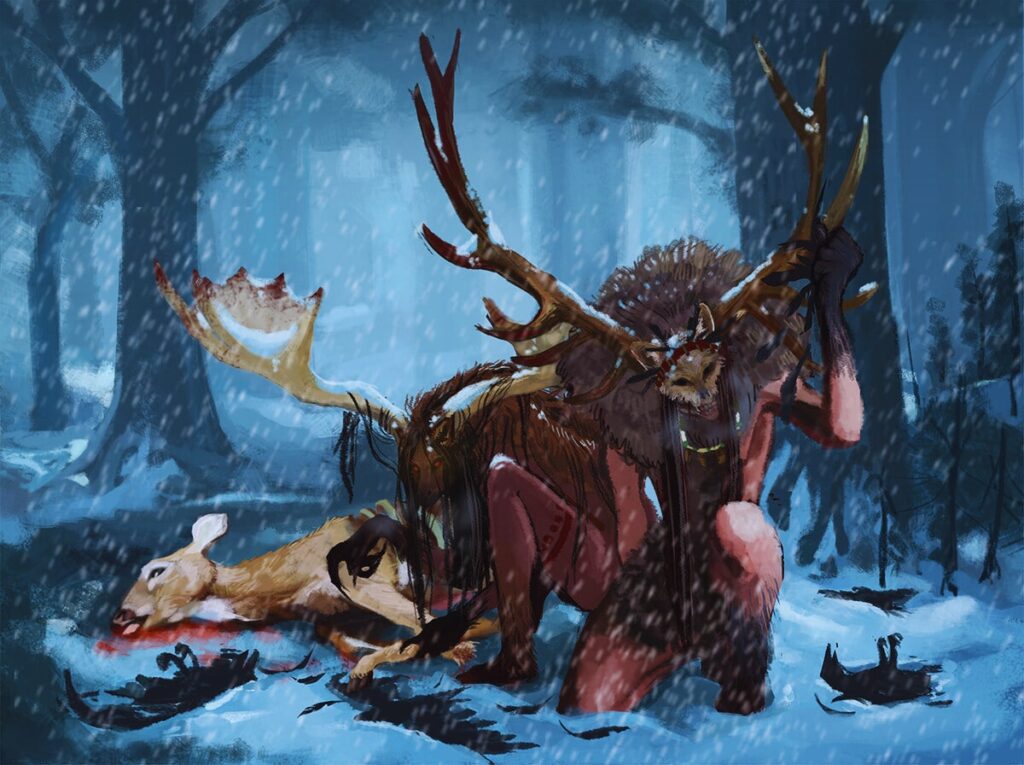
Historical encounters with skinwalkers are deeply woven into the cultural fabric of several Native American tribes, particularly within Navajo tradition. Skinwalkers, or “yee naaldlooshii,” are believed to be witches capable of transforming into, possessing, or disguising themselves as animals.
While specific historical encounters are not detailed in the provided search results, the phenomenon is notably pervasive in the American Southwest. Skinwalker Ranch in Utah, for instance, has become a focal point for reported skinwalker activity, alongside a plethora of other paranormal occurrences. This ranch is considered one of the world’s most significant hotspots for paranormal research, drawing attention to the ongoing mystery and fear surrounding skinwalkers.
Although much of the information about skinwalkers comes from oral traditions and is not extensively documented in historical records, the fear and respect for these entities persist. Their ability to cross the boundaries between the natural and supernatural worlds places them at the heart of many Navajo legends and cautionary tales, emphasizing their significant role in indigenous folklore.
Modern Day Sightings
Modern-day sightings and encounters with skinwalkers continue to intrigue and terrify people worldwide. Various platforms share alleged encounters, ranging from social media posts to dedicated paranormal investigation TV shows:
- Expedition X reported a “possible skin-walker sighting in Utah,” capturing the audience’s imagination and hinting at the ongoing presence of these entities in certain areas.
- The Secret of Skinwalker Ranch dives deep into investigating the high strangeness and mysterious phenomena, including UFO sightings and possibly skinwalker activity, at one of the world’s most enigmatic hotspots.
- A YouTube video titled “Was I Stalked By Skinwalkers? (2024)” shares a personal account of feeling stalked by skinwalkers during a hunt, adding to the collection of first-hand experiences shared by individuals.
- In New Mexico, a “recent ‘skinwalker’ photo ignites fear,” showcasing how modern technology can capture evidence that sparks widespread curiosity and concern about these legendary beings.
- Social media platforms like TikTok have become a hub for sharing encounters and stories about skinwalkers, with the hashtag #skinwalkersin2024 amassing millions of views. These videos range from alleged sightings to stories, showing the widespread interest in and fear of skinwalkers.
These sightings and accounts contribute to the evolving narrative of skinwalkers, blending ancient lore with modern experiences and continuing to fuel fascination and fear.
How to Protect Yourself
Cultural Dos and Don’ts
Protecting yourself from skinwalkers involves a mix of respecting cultural practices and taking practical steps. Here are some guidelines based on folklore and discussions:
- Avoidance: Don’t actively seek out or try to engage with skinwalkers. Encounters are often described as deeply unsettling or dangerous.
- Cultural Respect: Understand that skinwalkers are deeply rooted in specific Indigenous cultures, notably the Navajo. Showing respect for these cultures and their beliefs is crucial.
- Silence: Speaking about skinwalkers openly or using their name recklessly is often considered to invite trouble. Many believe that discussing them too openly can attract their attention.
- Spiritual Protection: For those who believe in the supernatural aspect of skinwalkers, employing spiritual or symbolic protection methods such as charms, prayers, or rituals from one’s own culture or the cultures familiar with skinwalkers may offer peace of mind.
It’s essential to approach the subject with sensitivity and awareness of the cultural significance and not trivialize or appropriate these beliefs.
Physical Protections
Physical protection against skinwalkers, according to folklore and various sources, involves several practices:
- Avoid eye contact: Locking eyes with a skinwalker might allow them to absorb into your body.
- Use of protective symbols and objects: Some beliefs suggest that having certain symbols or objects that carry spiritual significance can offer protection.
- Stay indoors at night: Skinwalkers are often associated with nocturnal activities, so staying indoors can provide a layer of safety.
- Avoid wearing animal skins: As skinwalkers are said to wear the skins of animals they transform into, avoiding wearing animal skins might prevent attracting their attention.
- Spiritual and ritualistic protections: Engaging in spiritual practices or rituals specific to one’s culture or belief system could offer protection against malevolent entities, including skinwalkers.
It’s important to note that beliefs about skinwalkers and methods of protection vary widely and are deeply rooted in the specific cultural contexts in which they are found, especially within Navajo tradition.
The Debate: Myth vs. Reality
Skeptic Views
The debate over the reality of skinwalkers straddles the line between myth, folklore, and personal belief. Skinwalkers originate from Navajo folklore, described as individuals with the supernatural ability to transform into animals. The legend of skinwalkers is deeply rooted in Native American culture, particularly among the Navajo, and is considered a significant part of their spiritual and cultural heritage.
However, from a skeptical viewpoint, the existence of skinwalkers is not supported by empirical evidence or scientific verification. The stories surrounding skinwalkers, including those related to Skinwalker Ranch, are often classified under paranormal phenomena, which inherently lack solid, verifiable proof. Skeptics argue that tales of skinwalkers and similar beings stem from human psychology and our propensity for storytelling, serving as cautionary tales or explanations for unexplainable events.
Moreover, the conversation about skinwalkers is also intertwined with concerns about cultural appropriation and the misunderstanding or sensationalization of indigenous beliefs. Skeptics and critics alike caution against trivializing these deeply held beliefs for entertainment or curiosity without understanding the cultural context and respect for the people who hold these legends to be a sacred part of their heritage.
Believer Insights
For many believers, the existence of skinwalkers transcends mere folklore or myth. These entities are deeply rooted in the cultural and spiritual traditions of Native Americans, particularly within the Navajo tribe. Skinwalkers are viewed as individuals who have gained the powerful ability to transform into, control, or impersonate animals and humans, often with malevolent intentions. This belief system underscores the respect and wariness with which these beings are regarded within certain communities.
The legend has also permeated popular culture, further cementing its place in the modern imagination. Social media platforms, such as TikTok, have played a role in amplifying the intrigue and fear surrounding skinwalkers, showcasing alleged encounters and stories that have reached millions of viewers. Moreover, places like Skinwalker Ranch in Utah have gained notoriety as hotspots for paranormal phenomena, drawing attention from both believers and skeptics alike and providing a physical locus for the legend’s modern manifestations.
For believers, skinwalkers are not dismissed easily as mere tales or superstitions. They represent a profound and respected element of spiritual and cultural lore, a testament to the complex relationship between humans, nature, and the supernatural.
Conclusion
The legend of the skinwalker is a fascinating blend of myth, culture, and mystery. Whether one views these stories as cautionary tales, supernatural encounters, or cultural heritage, they undeniably contribute to the rich tapestry of American folklore. As we explore the shadowy domain of skinwalkers, we tread a fine line between the known and the unknown, reminding us of the power of stories to evoke fear, curiosity, and respect for the mysteries that lie just beyond the edge of our understanding.
Read also: What Are Scallops?
